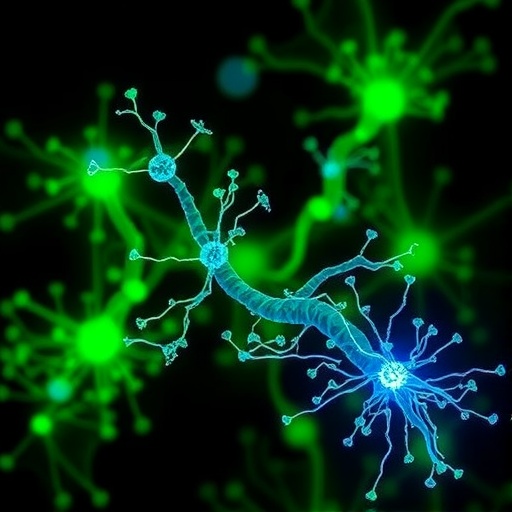In the relentless quest to understand the molecular underpinnings of neurodegenerative diseases, the identification and characterization of amyloid fibrils have remained a formidable challenge. Recent breakthroughs by a team led by Carroll, Yang, and Powell have unveiled an innovative high-throughput platform enabling the discovery of novel fluoroprobes that selectively recognize diverse amyloid fibril polymorphs. Published in Nature Chemistry, their work introduces powerful new tools poised to revolutionize the study of protein aggregation, a pathological hallmark implicated in Alzheimer’s, Parkinson’s, and related disorders.
At the heart of protein aggregation lies the formation of amyloid fibrils—highly ordered, β-sheet rich structures that accumulate abnormally in the brain and other tissues. Although these fibrils share a common hallmark morphology, accumulating evidence reveals astonishing polymorphic diversity extending to their molecular architecture and conformational strains. This polymorphism critically dictates disease progression, tissue tropism, and therapeutic response, yet current imaging and analytical probes fail to discriminate these subtle but consequential structural variants.
Recognizing this unmet need, Carroll and colleagues developed a sophisticated high-throughput screening methodology that bridges chemistry, structural biology, and computational analysis. By synthesizing and screening a sprawling library of candidate fluoroprobes, they systematically identified molecules with unique binding profiles tailored to discrete amyloid polymorphs. This targeted specificity was achieved by exploiting nuanced differences in the fibrils’ surface topography, hydrophobic pockets, and charge distributions—features often hidden to traditional dyes such as Thioflavin T.
.adsslot_bjg74ZWYOH{ width:728px !important; height:90px !important; }
@media (max-width:1199px) { .adsslot_bjg74ZWYOH{ width:468px !important; height:60px !important; } }
@media (max-width:767px) { .adsslot_bjg74ZWYOH{ width:320px !important; height:50px !important; } }
ADVERTISEMENT
Their screening platform is a tour de force of modern chemical biology. Employing combinatorial synthesis enabled rapid generation of diverse fluorophore scaffolds. Automated fluorescence assays measured binding kinetics and spectral shifts across multiple amyloid fibril types derived from distinct recombinant proteins and patient tissue extracts. Importantly, machine learning algorithms were integrated to extrapolate structure-activity relationships, guiding iterative refinement of probe designs with unprecedented efficiency and precision.
The implications of this work are profound. By furnishing an arsenal of polymorph-sensitive fluoroprobes, researchers can now visualize the heterogeneity of amyloid deposits with remarkable clarity in vitro, ex vivo, and potentially in vivo. This could unravel disease-specific fibril fingerprints, clarify pathogenetic mechanisms, and facilitate early diagnosis by distinguishing pathogenic strains before overt clinical manifestation. Moreover, such molecular discrimination holds promise for monitoring therapeutic interventions, enabling personalized and dynamic assessment of drug efficacy.
One of the remarkable findings was the identification of probes that not only fluoresce distinctly upon binding but also exhibit differential affinity for fibrils extracted from Alzheimer’s versus Parkinson’s disease brain homogenates. This specificity underscores the probes’ ability to detect conformational nuances at a level beyond conventional histological stains. The researchers also demonstrated compatibility with super-resolution microscopy, opening new geographic vistas into amyloid architecture within intact cellular environments.
At the molecular level, the design of these fluoroprobes draws inspiration from natural amyloid-binding peptides and small molecules but surpasses them in tunability and selectivity. The incorporation of flexible linkers and variable aromatic moieties allows fine-tuning of hydrophobic and electronic interactions critical for specific fibril engagement. Additionally, the probes’ photophysical properties were optimized to enhance brightness, photostability, and avoid spectral overlap with endogenous fluorophores, thereby improving signal-to-noise ratios in complex biological samples.
Beside diagnostic and investigative uses, these fluoroprobes may catalyze therapeutic innovations. By discriminating polymorphs, drugs could be engineered to target the most pathologically relevant fibril strains, circumventing off-target effects that plague current aggregation inhibitors. Furthermore, the binding modes elucidated through biophysical studies could guide the design of molecular chaperones or disaggregases that remodel toxic polymorphs into benign conformations.
The study also highlights challenges ahead. Translating these probes for clinical imaging will require ensuring biocompatibility, brain permeability, metabolic stability, and minimal toxicity. Additionally, the complexity of fibril polymorphism in heterogeneous patient populations demands extensive validation across diverse cohorts. However, the scalability of the high-throughput platform promises rapid expansion of the fluoroprobe repertoire, fostering adaptability to emerging polymorph discoveries.
Beyond neurodegeneration, amyloid polymorphs are implicated in systemic diseases such as type II diabetes and systemic amyloidosis, where sensitive detection remains elusive. The newly established probe discovery workflow positions the field to confront these challenges, providing versatile molecular tools to dissect amyloid biology in a spectrum of pathological contexts. This unified approach blends chemical innovation with computational analytics, heralding a new era in protein misfolding research.
The authors also emphasize the synergistic potential of coupling their fluoroprobes with emerging modalities like cryo-electron microscopy and solid-state NMR spectroscopy. Such integrative strategies could correlate fluorescence signatures with atomic-level structural resolutions, decrypting the structural basis of polymorphic diversity. This multidisciplinary convergence promises to decode the “strains” of amyloid fibrils analogous to prion biology, advancing our grasp of disease mechanisms.
Through open dissemination of their probe libraries and screening data, Carroll and colleagues foster a collaborative ecosystem, inviting researchers worldwide to explore amyloid polymorphism with unprecedented depth. This democratization of tools accelerates discovery, enabling the rapidly evolving field of protein aggregation to chart new frontiers in molecular pathology and therapeutics.
Ultimately, the technological leap presented in this study marks a pivotal stride toward precision molecular neurology. By illuminating the hidden diversity of amyloid fibrils with bespoke fluoroprobes, the research empowers scientists to unravel complex proteinopathies at a granular level. As these chemical sentinels illuminate the shadowy world of protein aggregation, they herald transformative prospects for early diagnosis, refined disease classification, and targeted intervention, instilling hope in the battle against debilitating neurodegenerative disorders.
Subject of Research: High-throughput discovery and characterization of fluoroprobes that selectively recognize distinct amyloid fibril polymorphs.
Article Title: High-throughput discovery of fluoroprobes that recognize amyloid fibril polymorphs
Article References:
Carroll, E.C., Yang, H., Powell, W.C. et al. High-throughput discovery of fluoroprobes that recognize amyloid fibril polymorphs. Nat. Chem. (2025). https://doi.org/10.1038/s41557-025-01889-7
Image Credits: AI Generated
Tags: advanced imaging techniques for protein aggregationamyloid polymorph discoverycharacterization of amyloid fibril polymorphscomputational analysis in biochemistryfluoroprobes for neurodegenerative diseaseshigh-throughput screening for amyloid fibrilsmolecular architecture of amyloid fibrilsnovel fluoroprobes for Alzheimer’sParkinson’s disease biomarkersprotein aggregation research toolsstructural biology in amyloid studiestherapeutic response in amyloid disorders





